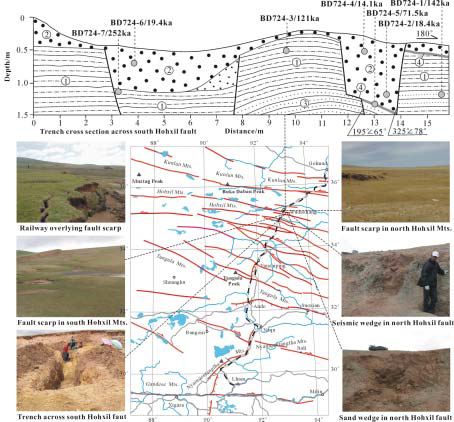Achievements
SLIP-RATE OF THE HOHXIL STRIKE-SLIPACTIVE FAULT
The Hohxil active fault system consists of the Qumarhe, Wudaoliang, north Hohxil, south Hohxil active faults (Wu et al., 2003). Typical faults, such as F16, F16-4, F17-2, F17-3, F18, cut deposits with ages of 4.5ka, 53.3ka, 3.7ka, 15.3k, and 6.0ka, giving average strike-slip rates of 7.78mm/a, 0-39mm/a, 6.76mm/a, 3.27mm/a and 1.50mm/a respectively (Table 2). Ms 7.0~7.5 Earthquake took place along south Hohxil fault (F18) in Holocene and formed a 4-4.5m sinistral offset of stream along a seismic scarp of more than 20km long and 1.5m high. Seismic fractures occur 5-10m east of the scarp, and are filled with brown sandy wedges and perennial elongated freezing domes with a NE orientation. Pull-apart basins accompany the seismic fractures in many localities (Fig.7).

Fig. 7 Photos of Hohxil strike-slip fault and cross section of trench
Explanation: 1. Brownish yellow calc sands; 2. Red sandy clay; 3. sands cemented by ice; 4. Greenish gray thin clay; BD724-4/14.1ka mark sample number/OSL age; 0218-6/6.0ka mark sample number/TL age.
Table 2 Slip-rates of Hohxil active faults for various time intervals





